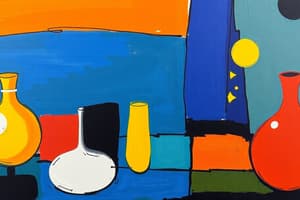Podcast
Questions and Answers
Which printing technique involves transferring ink from a flat surface to paper?
Which printing technique involves transferring ink from a flat surface to paper?
- Relief printing
- Planographic printing (correct)
- Intaglio
- Casting
What is the main characteristic of Impressionism?
What is the main characteristic of Impressionism?
- Use of bold, distorted forms
- Realistic representation
- Emphasis on light and color (correct)
- Emphasis on classical motifs
Which movement is characterized by the use of geometric shapes and fragmented forms?
Which movement is characterized by the use of geometric shapes and fragmented forms?
- Expressionism
- Renaissance
- Abstract Expressionism
- Cubism (correct)
What is the process of pouring liquid material into a mold and allowing it to solidify called?
What is the process of pouring liquid material into a mold and allowing it to solidify called?
Which technique involves carving away the negative space and inking the raised surfaces?
Which technique involves carving away the negative space and inking the raised surfaces?
Which visual art form involves the application of pigment, color, or other mediums to a surface?
Which visual art form involves the application of pigment, color, or other mediums to a surface?
Which technique involves making small lines to create shading and texture in a drawing?
Which technique involves making small lines to create shading and texture in a drawing?
Which visual art form uses a matrix to transfer ink onto a sheet of paper or material?
Which visual art form uses a matrix to transfer ink onto a sheet of paper or material?
What is the art of making marks on a surface to create an image, often using tools like pencils, charcoal, or pens?
What is the art of making marks on a surface to create an image, often using tools like pencils, charcoal, or pens?
Which painting technique involves applying multiple thin layers of paint on a surface?
Which painting technique involves applying multiple thin layers of paint on a surface?
Flashcards are hidden until you start studying
Study Notes
The world of arts is vast and diverse, encompassing various forms of expression that capture the imagination and evoke emotions. This article will delve into the realm of visual arts, exploring the different mediums, techniques, and movements that have shaped the course of art history.
Mediums and Techniques
Visual arts refer to the practice of creating art with visual elements such as color, form, and texture. These mediums include:
-
Painting: The application of pigment, color, or other mediums to a surface, typically using a brush or other tool. Notable techniques include impasto (thick layers of paint), glazing (applying multiple thin layers of paint), and fresco (painting on wet plaster).
-
Drawing: The art of making marks on a surface to create an image, often using a variety of tools such as pencils, charcoal, or pens. Techniques include hatching (making small lines to create shading and texture), cross-hatching (a variation of hatching where lines cross over each other), and stippling (applying small dots to create texture).
-
Printmaking: A technique that involves transferring ink from a matrix (a surface that holds the image to be transferred) to a sheet of paper or other material. Common techniques include relief printing (carving away the negative space and inking the raised surfaces), intaglio (incising lines into a surface and filling them with ink), and planographic printing (transferring ink from a flat surface to paper).
-
Sculpture: The art of creating three-dimensional objects by carving, modeling, or assembling materials such as stone, wood, or metal. Techniques include casting (pouring liquid material into a mold and allowing it to solidify), carving (removing material to create the desired shape), and assemblage (joining found or recycled objects to create a new sculpture).
Movements and Styles
Throughout history, various movements and styles have emerged in the visual arts, each with its unique characteristics and influences. Some of the most notable include:
-
Renaissance: A period of artistic, cultural, and intellectual flowering in Europe, characterized by a revival of classical motifs and a focus on realism and perspective.
-
Impressionism: A movement that emerged in the late 19th century, emphasizing the use of light and color to capture the impression of a scene, rather than a realistic representation.
-
Expressionism: A style that emerged in the early 20th century, characterized by the use of bold, distorted forms and intense colors to express emotions and inner feelings.
-
Cubism: A movement that originated in the early 20th century, characterized by the use of geometric shapes and fragmented forms to create a sense of depth and complexity.
-
Abstract Expressionism: A style that emerged in the mid-20th century, characterized by the use of non-representational forms and bold, gestural brushstrokes to evoke emotion and convey a sense of spontaneity.
In conclusion, the world of visual arts is a rich tapestry of mediums, techniques, movements, and styles that have shaped the course of art history. From the earliest cave paintings to the contemporary masterpieces of today, the visual arts continue to captivate and inspire us with their beauty, depth, and emotional resonance.
Studying That Suits You
Use AI to generate personalized quizzes and flashcards to suit your learning preferences.




